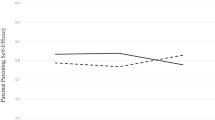Abstract
Identity is central to how one perceives the world and how one is perceived. There is no more meaningful life event nor more significant an identity crisis that an individual goes through as a human being than to become a parent. However, unlike other identities that an individual acquires over the course of life, this is an identity that continues to transition a child is growing and developing. Galinsky (1987) created a thought-provoking stage approach to describe parental development. This paper makes use of this model to trace the concurrent paths of parental identity and children’s growth and development with a narrative of my own experience as a parent.
Access this chapter
Tax calculation will be finalised at checkout
Purchases are for personal use only
Similar content being viewed by others
References
Arnett, J. J. (1998). Learning to stand alone: The contemporary American transition to adulthood in cultural and historical context. Human Development, 41, 295–315.
Arnett, J. J. (2000). Emerging adulthood: A theory of development from the late teen through the twenties. American Psychologist, 55(5), 469–480.
Elkind, D. (1967). Egocentrism in adolescence. Child Development, 38(4), 1025–1034.
Erikson, E. H. (1963). Childhood and society. New York: Norton.
Galinsky, E. (1987). The six stages of parenthood. Reading, MA: Perseus Books.
Levinson, D. J. (1978). The seasons of a man’s life. New York: Knopf.
Levinson, D. J., & Levinson, J. D. (1996). The seasons of a woman’s life. New York: Knopf.
Main, M., Kaplan, N., & Cassidy, J. (1985). Security in infancy, childhood, and adulthood: A move to the level of representation. Monographs of the Society for Research in Child Development, 50, 66–104.
Marcia, J. E. (1966). Development and validation of ego-identity status. Journal of Personality and Social Psychology, 3, 551–558.
Matas, L., Arend, R. A., & Sroufe, L. A. (1978). Continuity of adaptation in the second year: The relationship between quality of attachment and later competence. Child Development, 49(3), 547–556.
Piaget, J. (1972). The psychology of the child. New York: Basic Books.
Thompson, R. A. (2006). The development of the person: Social understanding, relationships, self, conscience. In W. Damon & R. M. Lerner (Series Eds.) & N. Eisenberg (Ed.), Handbook of child psychology (Vol. 3). Social, emotional, and personality development (6th ed., pp. 24–98). Hoboken, NJ: Wiley.
Author information
Authors and Affiliations
Corresponding author
Editor information
Editors and Affiliations
Rights and permissions
Copyright information
© 2017 Springer International Publishing AG
About this chapter
Cite this chapter
Fracasso, M.P. (2017). The Concurrent Paths of Parental Identity and Child Development. In: Sinnott, J. (eds) Identity Flexibility During Adulthood. Springer, Cham. https://doi.org/10.1007/978-3-319-55658-1_9
Download citation
DOI: https://doi.org/10.1007/978-3-319-55658-1_9
Published:
Publisher Name: Springer, Cham
Print ISBN: 978-3-319-55656-7
Online ISBN: 978-3-319-55658-1
eBook Packages: Behavioral Science and PsychologyBehavioral Science and Psychology (R0)




